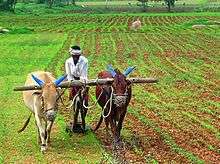Agricultural insurance in India
Agriculture in India is highly susceptible to risks like droughts and floods. It is necessary to protect the farmers from natural calamities and ensure their credit eligibility for the next season. For this purpose, the Government of India introduced many agricultural schemes throughout the country.

Pradhan Mantri Fasal Bima Yojana
The Pradhan Mantri Fasal Bima Yojana (Prime Minister's Crop Insurance Scheme) was launched by Prime Minister of India Narendra Modi on 13 February 2016.[1][2] It envisages a uniform premium of only 2 per cent to be paid by farmers for Kharif crops, and 1.5 per cent for Rabi crops. The premium for annual commercial and horticultural crops will be 5 per cent.[1]
Previous schemes
Farm Income Insurance Scheme
The Central Government formulated the Farm Income Insurance Scheme (FIIS) during 2003-04. The two critical components of a farmer's income are yield and price. FIIS targeted these two components through a single insurance policy so that the insured farmer could get a guaranteed income.
The scheme provided income protection to the farmers by insuring production and market risks. The insured farmers were ensured minimum guaranteed income (that is, average yield multiplied by the minimum support price). If the actual income was less than the guaranteed income, the insured would be compensated to the extent of the shortfall by the Agriculture Insurance Company of India. Initially, the scheme would cover only wheat and rice and would be compulsory for farmers availing crop loans. NAIS (explained in the section below) would be withdrawn for the crops covered under FIIS, but would continue to be applicable for other crops.
The FIIS was withdrawn in 2004.[3] The recent attempt by the Gujarat government to reintroduce the Farm Income Insurance Scheme (FIIS) can reform agricultural insurance and prevent farm-level distress.[4]
National Agriculture Insurance Scheme
The Government of India experimented with a comprehensive crop insurance scheme which failed. The Government then introduced in 1999-2000, a new scheme titled “National Agricultural Insurance Scheme” (NAIS) or “Rashtriya Krishi Bima Yojana” (RKBY).[5] NAIS envisages coverage of all food crops (cereals and pulses), oilseeds, horticultural and commercial crops. It covers all farmers, both loanees and non-loanees, under the scheme.
The premium rates vary from 1.5 percent to 3.5 percent of sum assured for food crops. In the case of horticultural and commercial crops, actuarial rates are charged. Small and marginal farmers are entitled to a subsidy of 50 percent of the premium charged- the subsidy is shared equally between the Government of India and the States. The subsidy is to be phased out over a period of 5 years.
NAIS operates on the basis of
- Area approach- defined areas for each notified crop for widespread calamities.
- On individual basis- for localized calamities such as hailstorms, landslides, cyclones and floods.
Under the scheme, each state is required to reach the level Gram Panchayat as the unit of insurance in a maximum period of 3 years. Agriculture Insurance Corporation of India is implementing the scheme.
References
- "Fasal Bima Yojana will solve farmers' problems: PM Modi", The Times of India, 18 February 2016
- "Crop insurance scheme will benefit farmers: Modi", Business Standard, 18 February 2016
- "Farm Income Insurance Scheme withdrawn". The Hindu Business Line. 11 June 2004. Retrieved 14 October 2011.
- http://www.thehindu.com/opinion/op-ed/protecting-the-small-farmer/article7065655.ece
- NationalAgriculturalInsuranceScheme (NAIS) / Rashtriya Krishi Bima Yojana (RKBY) Archived 4 January 2011 at the Wayback Machine